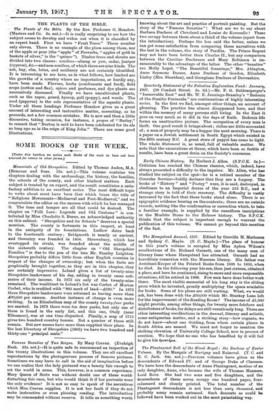SOME BOOKS OF THE WEEK.
[Under this bending see notice such Books of the week so have sot been reserved ler revise in other forms.]
Memorials of Old Shropshire. Edited by Thomas Auden, M.A. (Bemrose and Sons. 15s. net.)—This volume contains ten , chapters dealing with the archaeology, the history, the families, the schools of the county, and other kindred matters. Each subject is treated by an expert, and the result constitutes a satis- factory addition to an excellent series. The most difficult topic to write about must have been that which bears the title of " Religious Movements—Mediaeval and Post-Mediaeval," and we congratulate the editor on the success with which he has managed it The tone and temper are all that could be desired. The chapter on "Folk Lore : Legends and Old Customs" is con- tributed by Miss Charlotte S. Burne, an acknowledged authority on this aubiect. "Shropshire and its Schools" deserves a special mention. The county is fortunate in this respect, at least in the antiquity of its foundations. Ludlow dates back to the fourteenth century ; Bridgnorth is nearly as ancient, and Oswestry was founded in 1404. Shrewsbury, which has overtopped its rivals, was founded about the middle of the sixteenth century. The chapter on " Old Shropshire Families " is due to the pen of the late Mr. Stanley Leighton. Shropshire probably differs little from other English counties in respect of the changes of ownership; but when the facts are graphically brought together, as they are in this chapter, they are certainly impressive. Leland gives a list of twenty-nine Shropshire landowners of his day, adding in twenty cases esti- mates of their income. In 1873 six only of the twenty-nine remained. The wealthiest in Leland's list was Corbet of Morton Corbet, who is credited with "800 merk of land—..9530." In 1873 three Shropshire landowners were returned as having more than £30,000 per annum. Another instance of change is even more striking. In an Elizabethan map of the county twenty-four parks are marked. In 1873 there were ten deer parks, but only one of these is found in the early list, and this one, Otely (near Ellesmere), was at one time disparked. Finally, a map of 1715 gives two hundred country houses. Not a quarter of these still remain. But new names have more than supplied their place. In `the last Directory of Shropshire (1905) we have two hundred and thirty-one " principal seats."






































 Previous page
Previous page